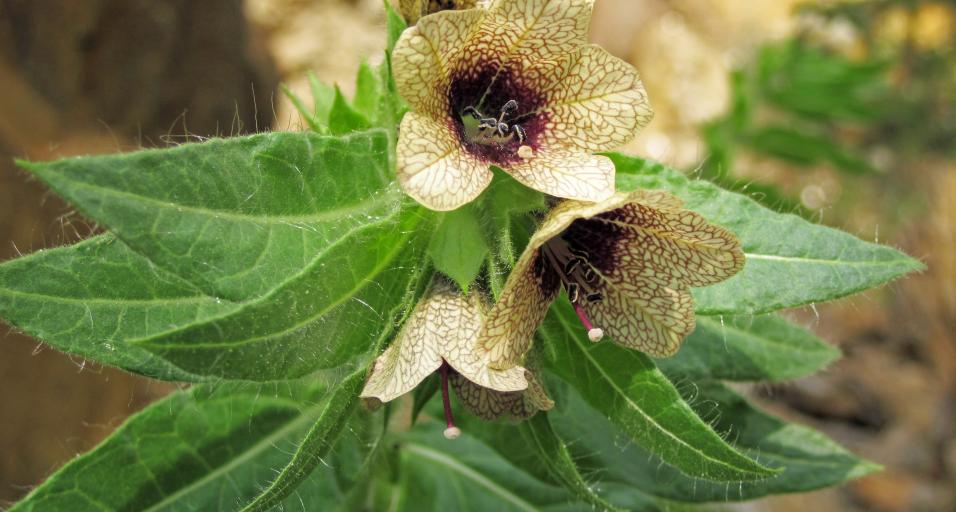A little bit about me.
My name is Hyoscyamus niger L., but people in Wyoming usually call me Black Henbane. I have other nick-names too, including Insane Root, Stinking Nightshade (although people disagree, I think I smell just fine), and Hog’s Bean (that’s the Greek translation of my name hyoscyamus; some nick-names have multiple origin stories, as I’m sure you can relate). I complete my lifecycle on either a one year (annual) or two year (biennial) cycle. People refer to me as a forb because I am an herbaceous flowering plant, but not a grass.
How I got here and my connections to Shakespeare
I grew up in Europe, but I’ve lived in the United States for a long time. In the US they call me an invasive species and a weed because I am a prolific seed disperser; I take advantage of disturbed areas and I out-compete native plants for resources. In contrast, I’ve been used for my medicinal properties in Europe since the first century AD. As an herbal medicine I have been used to treat everything from tooth aches to epilepsy to stomach pain. Brewers used to add me to beer to increase the inebriating effects, but that was prohibited after too many people were poisoned. Oh yeah, all of my plant parts are poisonous. You would likely get a skin rash if you just touched me and some of the symptoms from ingesting me include vomiting, diarrhea, rapid pulse, convulsions, and coma. Rumor has it that Shakespeare was referring to me when he described the tincture used to kill Hamlet’s father.
I do, however, contain two alkaloid components (hyoscyamine and scopolamine) that are useful in modern day western medicine when used under controlled conditions. I got to the US in the 17th century because of my medicinal, albeit dangerous, properties. People also brought me here as an ornamental plant because, not to brag, I have really pretty and unique flowers.
More about my good looks
I am a sturdy plant with large, coarsely toothed and hairy leaves and I grow from one to three feet tall. I usually flower from June to September with large brownish-yellow flowers with dark purple veins growing on a long raceme. After flowering, I produce robust fruits about one inch long with five lobes and each fruit contains hundreds of seeds. My brownish-gray to black, pitted seeds can persist in soils for up to four years. I have a thick and fleshy taproot. Looks are one thing, but people have referred to my smell as terrible, pungent, and characteristically foul. While I don’t appreciate the harsh words, my fragrance does protect me from getting munched!
Why I don’t belong here
Livestock doesn’t like my smell either and avoid eating me unless no other forage is available. This is a good thing because I am also poisonous to livestock and most mammals, as a matter of fact. I think that is why wildlife avoids me as well. In the US I can be found mostly in disturbed sites with sandy soils like roadsides, fence rows, pastures, and waste places. In these areas I compete with native plants for moisture, nutrients, and sunlight. The litter that I produce can even effect the germination and growth of native species. So I can’t be used for forage and I compete with desirable native plants for resources; I clearly shouldn’t be here.
How to get rid of me
You can find me scattered throughout the US, but I don’t belong here. There are ways to get rid of me, depending on how much I have infested an area. For small infestations you can hand pull me or dig me out, making sure to extract my entire taproot. I’d highly recommend wearing gloves for this. If I am bearing fruit be sure to put me in a bag so I don’t release my seeds. Also, burning plants with mature fruits will kill my seeds. You’ll want to check the area for seedlings for at least four years. For larger infestations, mechanical methods such as mowing, cutting, or disking can be used annually until my soil seed reserve is exhausted. Chemical controls including growth regulators (2,4-D, dicamba, picloram, etc.), aromatic amino acid inhibitors (glyphosate), or branched-chain amino acid inhibitors (chlorsulfuron, metsulfuron) are also effective. Most of the chemical treatments are nonselective herbicides and could damage other broadleaf species if applied haphazardly. Chemical and mechanical treatments should be used after I emerge, but before I flower to prevent more seed production and dispersal.
Because it is difficult to get rid of me selectively at a large scale, preventing infestation is the best control method. This includes using weed-free seeds and maintaining good native vegetation cover.
Hope to not see you soon,
Hyoscyamus niger L.
--
Story by: Cheyenne Stewart, WGFD Biologist in the Sheridan Region based out of Buffalo
Photo: Wikimedia Commons.

